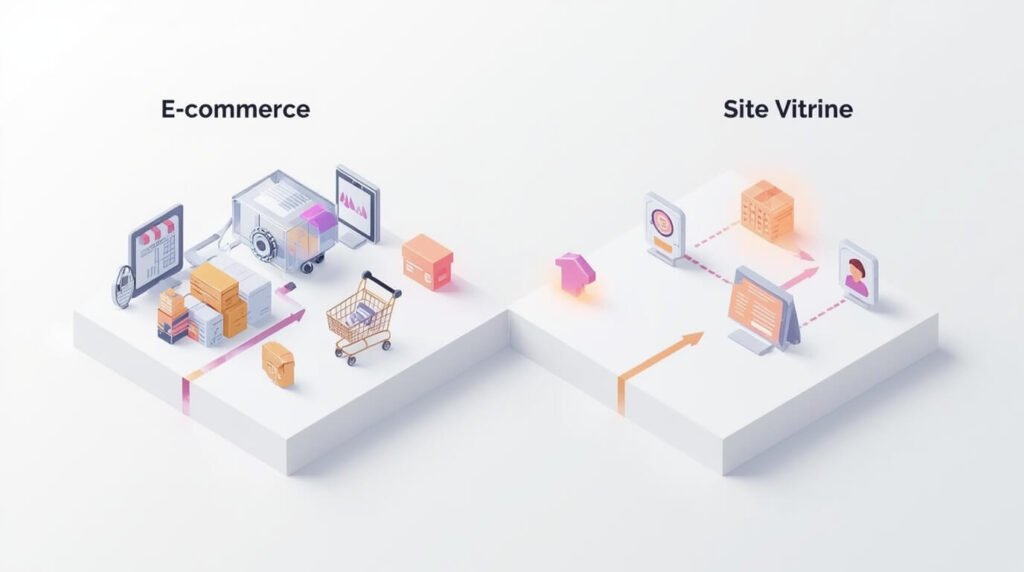
Picture this: you’re walking down a bustling street, and something catches your eye in a beautifully designed shop window. The elegant display draws you in, showcasing the business’s best offerings without overwhelming you with choices. That’s exactly what a site vitrine does for your online presence – it’s your digital storefront that makes that crucial first impression.
In today’s digital landscape, having an online presence isn’t just recommended; it’s essential. But with so many options available, from complex e-commerce platforms to simple landing pages, how do you choose what’s right for your business? Understanding the concept of a site vitrine and how it compares to other web solutions can help you make an informed decision that aligns perfectly with your business goals.
What Is a Site Vitrine?
A site vitrine, literally translated as “showcase website” from French, is a type of website designed primarily to present your business, services, or products in an attractive and informative manner. Think of it as your company’s digital business card, but much more sophisticated and engaging.
Unlike a site e-commerce that focuses on selling products directly online, a site vitrine serves as an informational hub. It’s designed to build credibility, showcase your expertise, and guide visitors toward contacting you or visiting your physical location. These websites typically include essential pages like “About Us,” “Services,” “Portfolio,” and “Contact,” creating a comprehensive overview of what your business offers.
The beauty of a site vitrine lies in its simplicity and focus. Rather than overwhelming visitors with countless product options and shopping carts, it presents information in a clean, organized way that helps potential customers understand your value proposition quickly.
Key Features of a Site Vitrine
Professional Presentation
A well-designed site vitrine acts as your 24/7 sales representative. It presents your business professionally, often featuring high-quality images, compelling copy, and a design that reflects your brand identity. Every element is carefully crafted to build trust and communicate your expertise.
Essential Information Hub
Your site vitrine serves as a central repository for all the information potential customers need. This includes your contact details, business hours, location, service descriptions, and team information. It answers the fundamental questions visitors have about your business before they even need to pick up the phone.
Lead Generation Focus
While a site vitrine doesn’t sell products directly, it’s highly effective at generating leads. Through strategically placed contact forms, clear calls-to-action, and compelling content, it guides visitors toward taking the next step in their customer journey – whether that’s scheduling a consultation, requesting a quote, or visiting your physical location.
Mobile-Responsive Design
Modern site vitrines are built with mobile users in mind. With more than half of web traffic coming from mobile devices, your showcase website must look and function perfectly on smartphones and tablets. This ensures you don’t miss potential customers who discover your business while on the go.
Site Vitrine vs Site E-commerce: Understanding the Difference

The distinction between a site vitrine and a site e-commerce is fundamental to choosing the right web solution for your business. Let’s break down these differences to help you understand which approach suits your needs better.
Purpose and Functionality
A site e-commerce is built for transactions. It includes shopping carts, payment gateways, inventory management, and order processing systems. Customers can browse products, make purchases, and complete transactions entirely online. Think of major retailers like Amazon or smaller online boutiques – they’re designed to facilitate sales directly through the website.
In contrast, a site vitrine focuses on information and lead generation. It showcases your offerings but doesn’t handle transactions. Instead, it encourages visitors to contact you through other means – phone calls, emails, or in-person visits.
Complexity and Maintenance
E-commerce websites are inherently more complex. They require regular updates for inventory, security patches for payment processing, and ongoing maintenance to ensure smooth transactions. They also need compliance with various regulations related to online sales and data protection.
Site vitrines are generally simpler to maintain. Once set up, they require occasional content updates and basic maintenance, making them more cost-effective in the long run for businesses that don’t need online selling capabilities.
Cost Considerations
The initial investment and ongoing costs differ significantly between these two approaches. A site e-commerce typically requires higher upfront development costs, monthly fees for payment processing, security certificates, and potentially more robust hosting solutions.
A site vitrine usually has lower initial costs and minimal ongoing expenses, making it an attractive option for small businesses or service providers who want a professional online presence without the complexity of e-commerce.
Who Should Consider a Site Vitrine?
Service-Based Businesses
Professional services like law firms, consulting agencies, architecture studios, or medical practices benefit enormously from site vitrines. These businesses don’t typically sell products online but need to establish credibility and make it easy for potential clients to learn about their services and contact them.
Local Businesses
Restaurants, salons, fitness studios, and other local businesses can use site vitrines effectively to showcase their offerings, display their location and hours, and encourage visits or reservations. The website serves as a digital extension of their physical presence.
Creative Professionals
Artists, photographers, designers, and other creative professionals can use site vitrines as digital portfolios. These websites showcase their work beautifully while providing easy ways for potential clients to inquire about services or commission work.
Small Retail Businesses
Even some retail businesses choose site vitrines over full e-commerce solutions, especially if they prefer handling orders personally or if their products are highly customized. The website showcases their products while directing customers to contact them for purchases.
Benefits of Having a Site Vitrine
Enhanced Credibility
In today’s digital age, consumers expect businesses to have an online presence. A professional site vitrine immediately establishes credibility and legitimacy. It shows that you’re serious about your business and invested in serving your customers well.
Improved Visibility
A well-optimized site vitrine helps potential customers find you through search engines. By including relevant keywords and local SEO elements, you increase your chances of appearing when people search for services like yours in your area.
Cost-Effective Marketing
Compared to traditional advertising methods, a site vitrine provides excellent return on investment. Once established, it works around the clock to attract and inform potential customers without ongoing advertising costs.
Better Customer Communication
Your website can answer frequently asked questions, provide detailed service information, and offer multiple ways for customers to contact you. This reduces the time you spend on repetitive inquiries and improves overall customer satisfaction.
Best Practices for Site Vitrine Design
Keep It Simple and Focused

The most effective site vitrines follow the principle of simplicity. Avoid cluttering your pages with too much information or too many design elements. Focus on what matters most to your visitors and present it clearly.
Prioritize Loading Speed
Website visitors are impatient – studies show that pages taking longer than three seconds to load lose a significant percentage of visitors. Optimize your images, choose reliable hosting, and keep your design clean to ensure fast loading times.
Include Clear Contact Information
Make it extremely easy for visitors to contact you. Include your phone number, email address, and physical address prominently on every page. Consider adding a contact form for visitors who prefer not to call immediately.
Use High-Quality Images
Visual elements play a crucial role in making a good first impression. Invest in professional photography or high-quality stock images that represent your business well. Poor-quality images can undermine your credibility quickly.
Optimize for Search Engines
Include relevant keywords naturally in your content, use proper heading tags, and ensure your website follows SEO best practices. This helps potential customers find you when they search for services like yours online.
Common Mistakes to Avoid
Overcomplicating the Design
While it’s tempting to include every possible feature, complexity often works against you. Visitors should be able to find the information they need quickly and easily. If your navigation is confusing or your pages are cluttered, you’ll lose potential customers.
Neglecting Mobile Users
With mobile traffic dominating web usage, a site vitrine that doesn’t work well on smartphones and tablets is a significant liability. Test your website thoroughly on various devices to ensure a smooth experience for all users.
Forgetting to Update Content
Stale content hurts your credibility and search engine rankings. Regularly update your site vitrine with fresh content, current information, and relevant keywords to maintain its effectiveness.
Missing Clear Calls-to-Action
Don’t leave visitors guessing about what to do next. Include clear, compelling calls-to-action that guide them toward contacting you or taking the next step in their customer journey.
FAQ Section
What’s the main difference between a site vitrine and a site e-commerce?
The primary difference lies in functionality and purpose. A site vitrine showcases your business and generates leads, while a site e-commerce enables direct online sales with shopping carts and payment processing. Think of a site vitrine as a digital brochure and a site e-commerce as a digital store.
How much does a site vitrine typically cost?
Costs vary widely depending on complexity, design requirements, and whether you hire professionals or use DIY platforms. Basic site vitrines can cost anywhere from $500 to $5,000, while custom professional designs may range from $3,000 to $15,000 or more.
Do I need technical skills to manage a site vitrine?
Modern content management systems make it possible for non-technical users to manage basic site vitrine updates. However, initial setup and design often benefit from professional expertise, especially if you want a truly polished result.
How long does it take to create a site vitrine?
Timeline depends on complexity and whether you’re working with professionals. Simple site vitrines can be completed in a few days to a few weeks, while custom designs with unique features may take several weeks to a few months.
Can a site vitrine help with local SEO?
Absolutely! Site vitrines are excellent for local SEO when optimized properly. Including your location, local keywords, and business information helps you appear in local search results and Google My Business listings.
Should I choose a site vitrine or site e-commerce for my business?
This depends on your business model and goals. Choose a site vitrine if you primarily want to showcase your services, build credibility, and generate leads. Opt for a site e-commerce if you want to sell products directly online and handle transactions through your website.
Conclusion: Making the Right Choice for Your Business
A site vitrine represents an excellent middle ground between a basic business listing and a complex e-commerce platform. It provides the professional online presence your business needs while remaining manageable and cost-effective. Whether you’re a service provider looking to attract new clients, a local business wanting to increase visibility, or a creative professional needing a digital portfolio, a well-designed site vitrine can be a powerful tool for growth.
The key to success lies in understanding your specific needs and creating a site vitrine that aligns with your business goals. Focus on clear communication, professional design, and user experience, and your digital storefront will serve you well for years to come.
Ready to explore how a site vitrine could benefit your business? Consider consulting with a web design professional to discuss your specific needs and goals. Share your thoughts in the comments below – we’d love to hear about your experiences with different types of websites and what worked best for your business!
